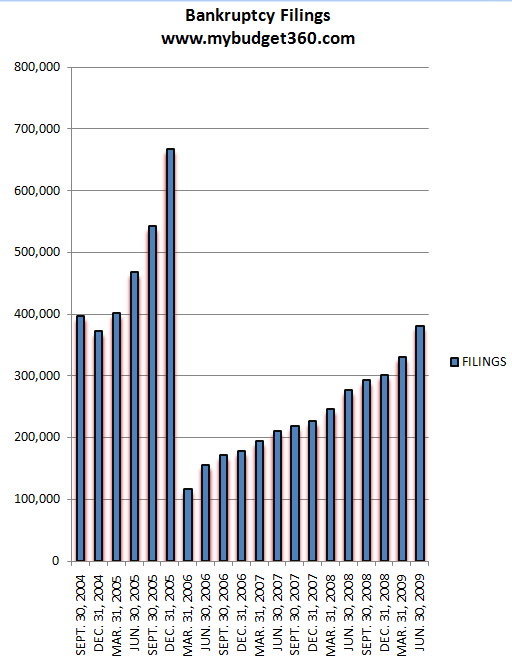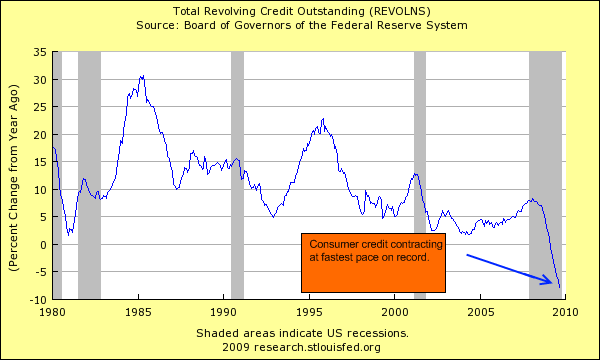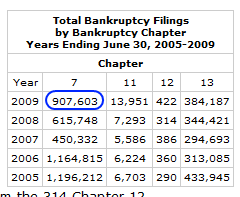Bankruptcy Filings Spiking: Chapter 7 Booming and 8 Years of Credit Card Industry Lobbying and $100 Million in Fees.
- 3 Comment
There is probably no bigger sign of economic distress than bankruptcy. It can be in the form of a business unable to pay debt obligations or an individual simply unable to keep up with former obligations. Most people that file for bankruptcy are not in a good economic spot. In fact, if you want a better indicator of economic health bankruptcy filings are a good measure. It is interesting what passes for good news in today’s market. For example, Alcoa announced a profit for the third quarter. Good news right? Well if you look into the details the company has cut 18,000 jobs in the 12 months ending on June 30th and also planned on cutting an additional $2.4 billion in costs. In this economic crisis people need to look at the details before assuming something is just good news.
Bankruptcy data doesn’t hide this. Since new legislation went into law in 2005, bankruptcy has been harder to file. So the recent increase in filings makes it all the more troubling:
Since 2005 the rise in quarterly bankruptcy filings has been steady. This is indicative of the nature of the current deep recession. The average American is feeling the strain of the high unemployment rate and the country is combating a market that is not willing to hire (i.e., Alcoa cutting jobs). And recent bankruptcy filing data is showing the trend still moving up. The latest data that we have is for August and it showed 119,874 consumer bankruptcy filings and that is a jump of 24 percent from last year.
You would think that with the massive amount of capital in banks, that lending would be easier so that would mitigate filings in the short-term but banks are not lending to consumers. Early this week we saw the continuing contraction in consumer credit:
Now these data points are important because they show what is really happening on Main Street. Wall Street is being pumped up by easy credit provided by the U.S. Treasury and Federal Reserve but most Americans don’t pay their monthly bills because the S&P 500 went up 10 points. Bankruptcy is the ultimate sign of distress. That is, someone has reached the point of financially being unable to meet obligations. This isn’t like missing one bill payment. This is someone sitting and looking at all their obligations and throwing in the towel.
Keep in mind that this new change comes in light of the 2005 tougher bankruptcy laws. That is why in the above, the chart shows a dramatic spike. What changed in 2005? A wide group of consumer advocates, legal scholars, and retired bankruptcy judges questioned the soundness of the legislation and recommended against it. The credit card industry lobbied hard. The contention was that bankruptcy was wrought with fraud. There wasn’t much data backing up that assertion but remember that in 2005 the good times were going on so hardly anyone was paying attention and the legislation was jammed through. The major changes included means testing but also shifting people into Chapter 13 instead of Chapter 7. The big difference here is with Chapter 13 people filing have to work out some kind of agreement to rework their obligations while in Chapter 7, current debts are paid from current assets. Of course this shifts the burden completely on the consumer instead of lenders actually spending the time to be more diligent. This worked perfectly in a mega housing bubble world. Take a look at Chapter 7 even in light of the tougher legislation:
The biggest proponents of the bill were the credit card industry. In fact, the credit card industry spent 8 years and $100 million in lobbying for this effort. If you look at the legislation, it actually enforces a means test by looking at your state median income. If you are at your state median income, you will not be able to qualify for Chapter 7 if you can pay 25 percent of the unsecured debt. What it does is that it allowed for credit card companies to give anyone and anything credit while shifting the burden to the states and consumers. Once things go bad as they are right now, credit is yanked from the system and now debtors are being forced to pay any penny they have to the credit card companies.
In the new legislation counseling is also required. Yet what about counseling for the credit card companies? The bill is a lobbyist dream and we are seeing the ramifications of this bill today. In fact, if it wasn’t for the bill we would be seeing tens of thousands more filing for Chapter 7 today but people are holding off because what use would it be to go into Chapter 13 and still need to pay off your debts?
What many of the credit card companies didn’t see however was the massive rise in unemployment. In fact, with 26 million unemployed and underemployed I’m sure many will be falling below the state median income test thus allowing people to file for Chapter 7 and liquidate. Unsecured debt like credit card loans are usually washed away in court hence the big lobbying by the credit card industry. So this is becoming a more likely option and as the chart shows above, more are opting for this. Take a look at brief breakdown of how this plays out:
Source:Â Bankruptcyaction
Only in some bizarre universe is spiking bankruptcies, foreclosures, and unemployment some sign of a rebounding economy.
If you enjoyed this post click here to subscribe to a complete feed and stay up to date with today’s challenging market!3 Comments on this post
Trackbacks
-
tal said:
As more people lose their jobs, state median income will fall, making it harder for those who file later rather than sooner…
October 8th, 2009 at 4:31 pm -
vitor said:
“Only in some bizarre universe is spiking bankruptcies, foreclosures, and unemployment some sign of a rebounding economy.”
That’s one great punch line.
October 9th, 2009 at 10:34 pm -
Bob said:
I think people are using it as Bankruptcy is a legal procedure by which the individuals and business houses can pay off their debts under the supervision of a bankruptcy court or wipe off their debts altogether.. Thanks for nice post. DIY4LAW
July 7th, 2010 at 10:53 pm




